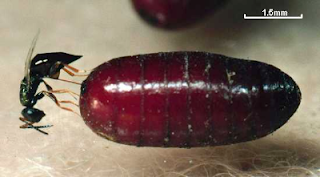The housefly (also house fly, house-fly or common housefly), Musca domestica, is a fly of the suborder Cyclorrhapha. It is the most common of all domestic flies, accounting for about 91% of all flies in human habitations, and indeed one of the most widely distributed insects, found all over the world; it is considered a pest that can carry serious diseases.
The adults are 8–12 mm long. Their thorax is gray, with four longitudinal dark lines on the back. The whole body is covered with hair-like projections. The females are slightly larger than the males, and have a much larger space between their red compound eyes. The mass of pupae can range from about 8 to 20 mg under different conditions.
Like other Diptera (meaning "two-winged"), houseflies have only one pair of wings; the hind pair is reduced to small halteres that aid in flight stability. Characteristically, the media vein (M1+2 or fourth long vein of the wing) shows a sharp upward bend.
Species that appear similar to the housefly include:
- The lesser house fly, Fannia canicularis, is somewhat smaller, more slender, and the media vein is straight.
- The stable fly, Stomoxys calcitrans, has piercing mouthparts and the media vein is only slightly curved.
Each female fly can lay approximately 500 eggs in several batches of about 75 to 150. The eggs are white and are about 1.2 mm in length. Within a day, larvae (maggots) hatch from the eggs; they live and feed on (usually dead and decaying) organic material, such as garbage or feces. They are pale-whitish, 3–9 mm long, thinner at the mouth end, and have no legs. They live at least one week. At the end of their third instar, the maggots crawl to a dry, cool place and transform into pupae, colored reddish or brown and about 8 mm long. The adult flies then emerge from the pupae. (This whole cycle is known as complete metamorphosis.) The adults live from two weeks to a month in the wild, or longer in benign laboratory conditions. Having emerged from the pupae, the flies cease to grow; small flies are not necessarily young flies, but are instead the result of getting insufficient food during the larval stage.
Some 36 hours after having emerged from the pupa, the female is receptive for mating. The male mounts her from behind to inject sperm. Copulation takes a few seconds to a couple of minutes. Normally, the female mates only once, storing the sperm to use it repeatedly for laying several sets of eggs.
The flies depend on warm temperatures; generally, the warmer the temperature, the faster the flies will develop
Housefly pupae are killed by parasitic wasp larvae. Each pupa has one hole through which a single adult wasp emerged; feeding occurs during the wasp's larval stage.
In colder climates, houseflies survive only with humans. They have a tendency to aggregate and are difficult to dispel. They are capable of carrying over 100 pathogens, such as those causing typhoid, cholera, salmonellosis, bacillary dysentery, tuberculosis, anthrax, ophthalmia, and parasitic worms. Some strains have become immune to most common insecticides.
House flies feed on liquid or semiliquid substances beside solid material which has been softened by saliva or vomit. Because of their high intake of food, they deposit feces constantly, one of the factors that makes the insect a dangerous carrier of pathogens. Although they are domestic flies, usually confined to the human habitations, they can fly for several miles from the breeding place. They are active only in daytime, and rest at night, e.g., at the corners of rooms, ceiling hangings, cellars, and barns, where they can survive the coldest winters by hibernation, and when spring arrives, adult flies are seen only a few days after the first thaw.
- parasitic diseases: cysts of protozoa e.g. Entamoeba histolytica, Giardia lamblia and eggs of helminths, e.g., Ascaris lumbricoides, Trichuros trichura, Haemenolypes nana,Hymenolepis nana, Enterobius vermicularis.
- bacterial diseases: typhoid, cholera, dysentery, pyogenic cocci, etc. House flies have been demonstrated to be vectors of Campylobacter and E. coli O157:H7 using PCR. House flies can be monitored for bacterial pathogens using filter paper spot cards and PCR
- Viruses: enteroviruses: poliomyelitis, viral hepatitis (A & E)..etc.



No comments:
Post a Comment